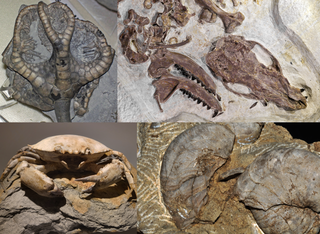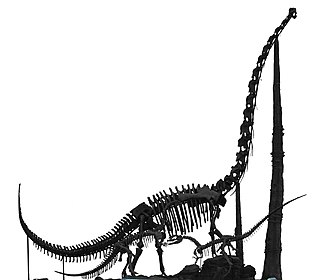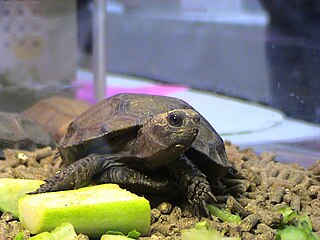Related Research Articles

A chordate is a deuterostomic animal belonging to the phylum Chordata. All chordates possess, at some point during their larval or adult stages, five distinctive physical characteristics (synapomorphies) that distinguish them from other taxa. These five synapomorphies are a notochord, a hollow dorsal nerve cord, an endostyle or thyroid, pharyngeal slits, and a post-anal tail. The name "chordate" comes from the first of these synapomorphies, the notochord, which plays a significant role in chordate body plan structuring and movements. Chordates are also bilaterally symmetric, have a coelom, possess a closed circulatory system, and exhibit metameric segmentation.

Beetles are insects that form the order Coleoptera, in the superorder Holometabola. Their front pair of wings are hardened into wing-cases, elytra, distinguishing them from most other insects. The Coleoptera, with about 400,000 described species, is the largest of all orders, constituting almost 40% of described insects and 25% of all known animal species; new species are discovered frequently, with estimates suggesting that there are between 0.9 and 2.1 million total species. Found in almost every habitat except the sea and the polar regions, they interact with their ecosystems in several ways: beetles often feed on plants and fungi, break down animal and plant debris, and eat other invertebrates. Some species are serious agricultural pests, such as the Colorado potato beetle, while others such as Coccinellidae eat aphids, scale insects, thrips, and other plant-sucking insects that damage crops.

A fossil is any preserved remains, impression, or trace of any once-living thing from a past geological age. Examples include bones, shells, exoskeletons, stone imprints of animals or microbes, objects preserved in amber, hair, petrified wood and DNA remnants. The totality of fossils is known as the fossil record.
Panthera is a genus within the family Felidae that was named and described by Lorenz Oken in 1816 who placed all the spotted cats in this group. Reginald Innes Pocock revised the classification of this genus in 1916 as comprising the tiger, lion, jaguar, and leopard on the basis of common features of their skulls. Results of genetic analysis indicate that the snow leopard also belongs to the genus Panthera, a classification that was accepted by IUCN Red List assessors in 2008.

Chuanjiesaurus is a genus of sauropod dinosaurs from the middle Jurassic Period. They lived in what is now China. The type species, Chuanjiesaurus anaensis, was first described by Fang, Pang, Lü, Zhang, Pan, Wang, Li and Cheng in 2000. Fossils of the species were found in the village of Chuanjie, Lufeng County, Yunnan Province, and are named after the location where the fossils were discovered. Holtz gave a length of 25 meters.

Manouria is a genus of tortoises in the family Testudinidae. The genus was erected by John Edward Gray in 1854.

The Mordellidae are a family of beetles commonly known as tumbling flower beetles for the typical irregular movements they make when escaping predators, or as pintail beetles due to their abdominal tip which aids them in performing these tumbling movements. Worldwide, there are about 1500 species.
Liushusaurus is an extinct genus of lizard described by Susan E. Evans and Yuan Wang in 2010. The genus has a single species, Liushusaurus acanthocaudata, and is known from eight fossils, several of which preserve soft tissue detail. The specimens were found in the Lower Cretaceous aged Yixian Formation of Northeast China. Liushusaurus is one of eight lizards that are known and have been named from the Yixian Formation, part of the diverse Jehol Biota ecosystem.
Iaceornis is a prehistoric marine bird genus endemic to North America during the Late Cretaceous living about 83.5 mya. It is known from a single fossil specimen found in Gove County, Kansas (USA), and consisting of a partial skeleton lacking a skull.

Palaeomedusa testa is an extinct species of thalassochelydian turtle from the Tithonian of the Late Jurassic. It was first described by the German palaeontologist Christian Erich Hermann von Meyer in 1860. It is the only species classified under the genus Palaeomedusa.
Qantas is a genus of trematosauroid temnospondyl from the Early Triassic. Fossils have been found from the Kamennyi Yar Formation in Borsky District, Samara Oblast. The type species Qantas samarensis was named in 2012 and placed in the family Benthosuchidae, as it was viewed as a close relative of Benthosuchus. The subfamily Qantasinae was established to include Qantas, and possibly the genus Tirraturhinus. Qantas is named after the Australian airline Qantas, which supported the original study of the fossils.
Ermischiella is a genus of beetles in the family Mordellidae, containing the following species:
Glipostena is a genus of beetles in the family Mordellidae, containing the following species:
Mordellina is a genus of tumbling flower beetles in the family Mordellidae.
Mordellistenoda is a genus of beetles in the family Mordellidae, containing the following species:
Stenalia cechovskyi is a beetle in the genus Stenalia of the family Mordellidae. It was described by Jan Horák in 2006 and is endemic to Malaysia where it was discovered in Cameron Highlands. The species is black in colour and have dark yellow elytron.
Stenalia jakli is a beetle in the genus Stenalia of the family Mordellidae. It was described in 2006 by Horák on Sumba island in Indonesia. The species' metatibia and elytron are black in colour. The name derived from Stanislav Jákl, an entomologist who worked with Horák.
Stenalia jendeki is a beetle in the genus Stenalia of the family Mordellidae. It was described in 2006 by Horák and is endemic to Cambodia. The species is black coloured and is 4.8–7.3 millimetres (0.19–0.29 in) long. The species is named after Eduard Jendek, an entomologist with whom Horák worked.
The Stenaliini are a tribe of beetles in the family Mordellidae.

Tasbacka is an extinct genus of sea turtle containing several species.
References
- ↑ Liu, M.; Lu, W.; Ren, D. 2007: A new fossil mordellid (Coleoptera: Tenebrionoidea: Mordellidae) from the Yixian Formation of western Liaoning Province, China. Zootaxa, (1415): 49-56. abstract & excerpt (PDF) full article (PDF)